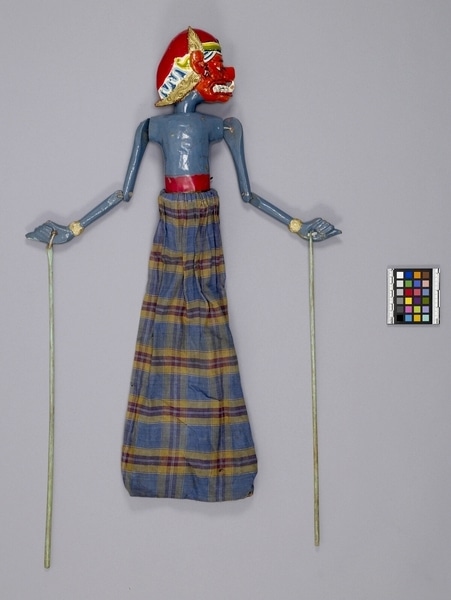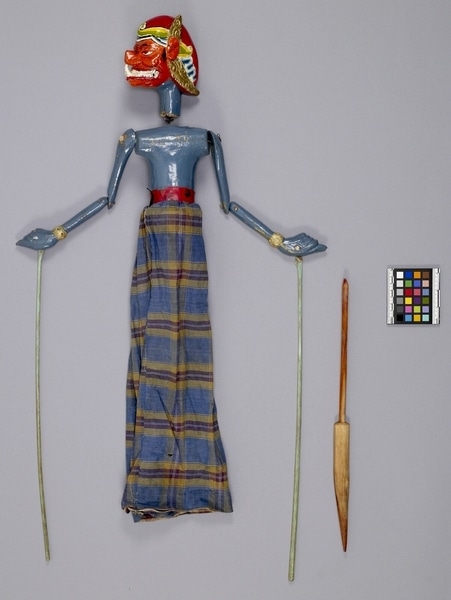Rod Puppet Item Number: Ib351 a-c from the MOA: University of British Columbia


Description
Three-dimensional male humanoid puppet: large head (part b) fits into body with skirt (part a), and a control rod (part c) with a long shaft that passes through the body and fits into the neck of the figure's head. The control rod is mostly stained with a reddish-brown colour. The body has jointed arms, each with a long controlling rod attached Orange face and ears; blue neck, torso and arms. Wearing elaborate headdress and gathered skirt. Large bulging eyes: irises red. Upper and lower teeth bared, tow fangs in corners of mouth: central lower fang curves up to pierce nose. Headdress composed of red skull-cap, gold ear ornaments, green and yellow band across forehead with curl in centre front. White, blue zigzag design above lower ear ornament. Gold wrist bracer. Skirt made of purple, blue, and yellow checkered cloth gathered at waist; red plastic taped around midriff. Head movement controlled by wood rod, which extends from head to handle beneath skirt. Arms jointed at elbow and shoulder, movement controlled by thin wands attached to hands.
History Of Use
Javanese puppetry as an art form probably developed by the 11th century. The three-dimensional wooden wayang golek puppets of western Java appeared during the 16th century. Originally the plays depicted Javanese mythology, but after the Indian conquest of Java the Hindu epics, Ramayana and Mahabharata, were incorporated into the cycles, which comprise about 200 plays. An individual or group hires a dalang (puppet-master) to celebrate important occasions. The performances often last all night and are generally presented in three acts, with vocal and instrumental accompaniment. The individual plays vary widely in detail but usually involve conflict between good and evil. They serve a moral and religious purpose, and more recently, one of political commentary. Each puppet's character is represented by its appearance and placement onstage; protagonists with strong elements of good are placed to the right, antagonists of violent or evil nature to the left. Buta Cakil is a noble ogre who leads a demon army against the good characters of almost every play. He would appear to the left. Ogres are considered foreigners in the plays, although they are an indigenous Javanese adaptation to the Hindu epics upon which the plays are based.
Cultural Context
Theatrical performance.
Iconographic Meaning
Bulging red eyes, big nose, and fangs are characteristics of ogres or rakshasa (demons, ogres). However, the position of his hand, finely detailed facial features, and elaborate headdress with gold ear ornaments are indicative of his high rank and relatively distinguished nature. The central fang from lower tooth row to nose identifies this character as Buta Cakil, leader of the ogre army, who clash with heroes in almost any play, regardless of the cycle.
Item History
- Made in Java, Indonesia
- Owned by Tradewind Antiques before March 15, 1983
- Received from Museum of Anthropology Shop Volunteers (Funding source) and Tradewind Antiques (Seller) on March 15, 1983
What
- Name
- Rod Puppet
- Identification Number
- Ib351 a-c
- Type of Item
- puppet
- Material
- wood, cotton fibre, paint, adhesive, fibre, rubber and metal
- Manufacturing Technique
- carved, painted and sewn
- Part A
- height 75.0 cm, width 19.0 cm, depth 8.0 cm
- Part B
- height 15.0 cm, width 7.5 cm, depth 12.0 cm
- Part C
- height 41.0 cm, width 2.4 cm, depth 1.8 cm
Who
- Culture
- Sundanese
- Previous Owner
- Tradewind Antiques
- Received from
- Museum of Anthropology Shop Volunteers (Funding source) and Tradewind Antiques (Seller)
Where
- Holding Institution
- MOA: University of British Columbia
- Made in
- Java, Indonesia
When
- Ownership Date
- before March 15, 1983
- Acquisition Date
- on March 15, 1983
Other
- Condition
- fair
- Accession Number
- 0886/0085 a-c